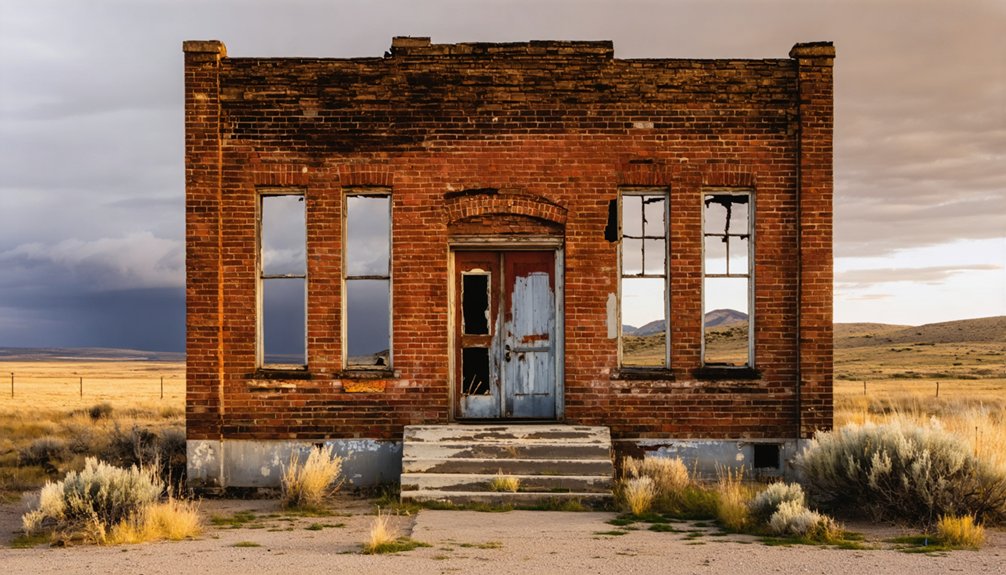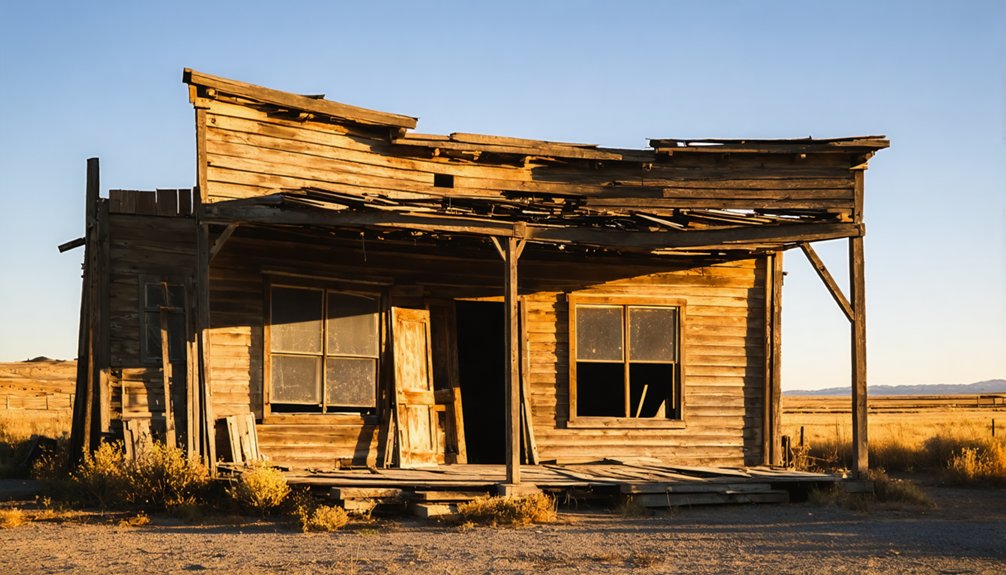You’ll discover Twin Springs, Idaho’s historic ghost town, established during the 1877 gold rush along the Middle Fork Boise River. The site features a well-preserved store that once served as the community’s multipurpose hub, including roles as a school and lodging house. Remnants of an innovative hydraulic mining operation, including timber sluices and water channels, still dot the landscape. The remote location’s arid climate has helped preserve these fascinating structures for modern exploration.
Key Takeaways
- Twin Springs was established in 1877 following gold discoveries and became a significant mining settlement utilizing placer and hydraulic mining methods.
- The historic Twin Springs store served multiple community functions, including school, lodging house, and supply center during mining operations.
- Located along the Middle Fork Boise River, the ghost town features preserved structures amid Artemisia-covered hills and mountainous terrain.
- Mining infrastructure remains visible today, including wooden sluice systems and evidence of hydraulic mining operations from the 19th century.
- The remote site is accessible via Interstate 70 and requires careful exploration due to preservation concerns and safety considerations.
The Rise of a Mining Community
As prospectors discovered promising gold deposits near Twin Springs in 1877, a vibrant mining community began to take shape in central Idaho.
You’ll find that the area’s rich potential for gold extraction quickly attracted miners who implemented various mining techniques, with placer mining emerging as the primary method of operation.
At the turn of the 20th century, the introduction of hydraulic giant operations marked a significant advancement in the region’s mining capabilities.
The arrival of hydraulic giants revolutionized Twin Springs’ mining landscape, ushering in a new era of efficient gold extraction.
The abundance of timber and water resources supported both the mining operations and the community’s development.
This pioneering spirit led to remarkable economic growth, as evidenced by the construction of extensive infrastructure, including an impressive siphon project and sluice lines.
The Glory Hole site became renowned for its exceptionally high gold yields throughout the region.
The mining activities didn’t just sustain Twin Springs; they transformed it into a vital hub within Idaho’s thriving gold-producing region.
Early miners in the region could earn up to two thousand dollars per week during peak production periods.
Life at Twin Springs Store and Cabin
The Twin Springs store stood as the beating heart of this remote mining settlement, serving far beyond its role as a simple trading post.
Much like the boarding houses that once filled Dunnville, the store provided critical lodging services to the community.
You’d find it functioning as a school, lodging house, kitchen, and home – a true multipurpose hub that adapted to the community’s evolving needs. Through several expansions, the original cabin grew to accommodate the increasing demands of local life.
The store’s historical significance stems from its role as the center for community gatherings, where residents could access essential supplies while connecting with neighbors. During the Depression era, the store served as a vital source of baked goods and eggs for local miners.
Under the guidance of notable figures like Nellie Hirt and with support from local rangers, the store became crucial to survival in this challenging environment.
Today, the original structure still stands, proof of the resilience of Twin Springs’ early settlers.
Engineering Marvel: The Sluice System
Standing as a proof of 19th-century ingenuity, Twin Springs’ sluice system stretched for miles across Idaho’s rugged terrain, delivering essential water supplies to gold-bearing gravels through an intricate network of wooden aqueducts.
You’ll find this remarkable hydraulic engineering achievement was constructed from local timber, joined by heavy iron spikes that you can still spot in the meadows today.
The sluice design masterfully adapted to the mountainous landscape, managing significant elevation changes through gravity-fed channels without modern pumping equipment.
While no blueprints survive, the system operated for decades, supporting both small-scale placer and large hydraulic mining operations.
Despite the lack of original plans, Twin Springs’ enduring sluice network served mining operations of all sizes for generations.
Today, you can explore the visible remains of this impressive infrastructure – a demonstration of frontier innovation that helped establish Idaho as America’s primary gold producer of its era.
Natural Beauty Meets Mining Heritage
While pioneering engineers carved out Twin Springs’ remarkable sluice network, nature’s raw beauty remained undiminished throughout the area’s mining era.
You’ll find yourself surrounded by an endless sea of Artemisia-covered hills, with the untamed Middle Fork Boise River flowing just as it did during the gold rush days.
The site perfectly balances natural conservation with historical preservation – wooden sluice timbers still peek through meadow grasses, offering glimpses into the past as you hike the rolling terrain.
The mountainous landscape that once supplied timber for mining operations now provides pristine wildlife habitat, while remnants of hydraulic mining infrastructure serve as evidence of human ingenuity amidst this rugged wilderness.
Exploring Twin Springs Today
Adventurous explorers who visit Twin Springs today will discover a blend of natural wilderness and historical remnants from Idaho’s mining era.
The region’s arid climate conditions help preserve any abandoned structures still standing at the site.
You’ll need to come prepared, as the site’s remote location demands proper gear and safety awareness. The site sits along Interstate 70, making it accessible for history enthusiasts. While specific tourism impact data for Twin Springs isn’t available, ghost towns throughout Idaho continue drawing history enthusiasts and outdoor adventurers year-round.
Summer offers the best conditions for exploring the area, though preservation challenges mean you’ll need to tread carefully around any remaining structures.
Like other Idaho ghost towns, Twin Springs provides a window into the region’s mining heritage, though it’s less documented than popular sites like Bayhorse or Silver City.
Local authorities work to maintain these historical treasures while balancing accessibility with conservation efforts.
Frequently Asked Questions
What Wildlife Can Visitors Commonly Encounter Around Twin Springs Today?
Like checking your Instagram feed, you’ll spot diverse wildlife species including bald eagles, moose, coyotes, and black bears. You’ll also see elk, river bluets, and bobcats during your visitor experiences.
Are Metal Detectors Allowed for Artifact Hunting at Twin Springs?
You can’t use metal detectors for artifact hunting at this historic site. Metal detecting regulations protect artifact preservation, and federal law strictly prohibits removing archaeological items from ghost towns without proper permits.
What Was the Total Amount of Gold Extracted From Twin Springs?
Like panning for certainty in muddy waters, you’ll find exact gold extraction figures elusive, though historical records suggest around $150,000 worth was produced through various mining methods at Twin Springs bars.
Did Any Notable Historical Figures Ever Visit Twin Springs?
While Twin Springs held historical significance during the mining era, you won’t find records of famous visitors there. Local legends might suggest influential figures passed through, but there’s no documented evidence.
What Happened to the Original Residents After the Mining Operations Ceased?
You’d find that thousands of residents scattered as economic decline hit hard, with families migrating to nearby towns and cities for better jobs, while others sought work in different Idaho mining camps.
References
- https://www.themandagies.com/haunted-places-in-idaho/
- https://www.twinspringsidaho.com/about/
- https://www.youtube.com/watch?v=RNCaxrY62ZI
- https://www.ghosttowns.com/states/id/twinsprings.html
- https://983thesnake.com/150-yr-old-kilns-up-the-road-from-hot-springs-north-of-twin-falls/
- https://www.hmdb.org/m.asp?m=124144
- https://www.outsideonline.com/adventure-travel/destinations/haunted-hikes/
- https://visitidaho.org/things-to-do/ghost-towns-mining-history/
- https://yellowpinetimes.wordpress.com/2024/04/14/idaho-history-apr-14-2024/
- https://history.idaho.gov/wp-content/uploads/2018/12/0162.pdf



